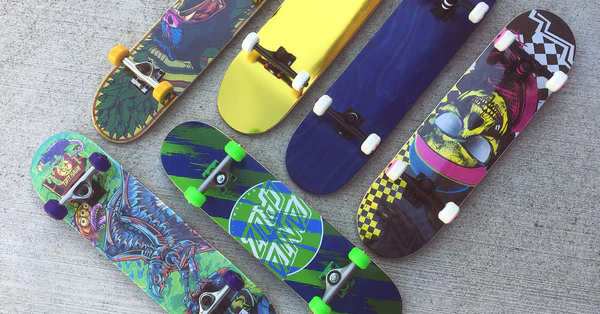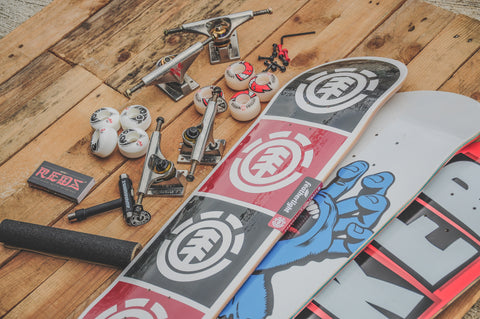Mar . 16, 2024 10:48 Back to list
Skateboard-BUYING YOUR FIRST SKATEBOARD - A BEGINNERS GUIDE 2024
Welcome to our beginners guide to buying your First Skateboard, we'll answer the most common questions and help you decide on the right board for you. Here at Gorgeous, we offer a huge range of skateboards, different brands, shapes, sizes, for different ages and abilities, to be honest, it's a little daunting at first! This buyers guide will make it easy so you can make the right decision when buying your first skateboard.
First, what type of skateboarding do you want to do?
The first thing you need to decide is what kind of skateboarding do you want to do, there are many types of skateboarding including street, skateparks, longboarding, cruising. Understanding what you want to get out of your skateboard will help you choose the right type of board.
Do you have a skatepark nearby and want to learn how to ollie and do tricks? Do you think you're more likely to be cruising around, commuting, rolling around campus? Or maybe you're buying a first skateboard for a young child so they can get to grips with the basics?
For the rest of this guide, we will assume you have decided you want to skateboard at skateparks, parks or the street as these are the most popular.
What to look for when buying your first Skateboard
Getting your first skateboard is a proud moment, you'll always remember that first board! You want a board that looks awesome with a good build quality to give yourself the best start for your budget. The more you love the look of your board the more you'll want to ride it, the more you'll progress and stick with it.
Typically, the low-cost skateboards found on Amazon, Argos or in toy shops are often poor quality and offer terrible value for money. This is because they are simply cashing in on-demand and not particularly concerned about making a quality product or even understanding basic user requirements!
There are several options when buying your first skateboard, let's take a look at the most common options available...
Complete Skateboards
The most common first board is a Complete Skateboard, as the name implies, you get everything you need already assembled and ready to ride. The benefits are you don't need to know about selecting and pairing all the right parts, you can simply pick the design you like on the right size board. This is often the most cost-effective way to get into skateboarding. Check out our range of Complete Skateboards For Beginners here...
Complete Skateboard Kits
Similar to a complete skateboard, you get everything you need to build a skateboard but it comes unassembled. The benefits are that you can get that more expensive/exclusive deck you really wanted and not have to worry about knowing the right size parts to go with it. This will be a bit more expensive than a complete skateboard but still an affordable way to get a great quality skateboard. Assembling it yourself is easy and a fun way to get to know your new skateboard. Check out our range of Complete Skateboard Kits here...
What to avoid when buying a Skateboard
There are telltale signs of a poor quality complete skateboard, ideally, you should avoid buying skateboards with the following:
• Plastic skateboard decks. Instead, plywood-based decks have superior shapes and are better suited to tricks.
• Plastic trucks or any fixed trucks that do not lean or turn. Instead, metal alloy trucks that have 2 polyurethane bushes that allow the skateboard to turn.
• Hard plastic wheels or super-soft rubber wheels. Instead, polyurethane wheels are the best balance of grip and durability, look for a durometer rating between 90a and 100a.
What Size Skateboard Should I Buy?
Skateboards come in many different sizes to suit different riders. They are usually sized by width, common widths are 7.75", 8.0" and 8.25". The lengths vary too but this is less important, street skateboards are usually around 32" long. They are also grouped by Full-Sized Skateboards and Junior Sized Skateboards.
I WEAR SIZE 8 SHOES, WHAT SIZE SKATEBOARD DO I NEED?— A New Skater
We get this question a lot! Choosing a width depends on your age, experience and what type of skating you want to do. Some people will recommend you choose a deck size based on your shoe size, this isn't necessarily the right advice for beginners as technically you can ride any width deck, your height is more important.
Why the difference in widths? Thinner boards, 7.75" and below, will be lighter which helps with ollies (jumping the board!) and will flip faster (a spin trick!) but they will have less room on the deck for your feet making it a bit harder to land big tricks.
Wider boards, over 8.0", are heavier and so require more effort to do tricks, but they have much more space on the deck for foot control and more room for error when landing tricks.
For beginners, we recommend you pick a skateboard based on your age and height. If you're under 10 years old or under 5ft tall then we recommend a Junior sized skateboard, if you're over 10 years old or over 5ft then you'll be suited to a full-sized skateboard.
Full Size Skateboards
If you are over 10 years old then a full-size skateboard will probably suit you better. They come in various deck widths ranging anywhere from 7.5" to 8.5" and lengths around 32". To start with, we recommend a deck width of 7.75" or 8.0".
Most full-sized complete skateboards will come in either 7.75" or 8.0" widths, this is the right size to start with, as your experience grows you'll know if you need a wider board later on. Check out our range of Full Size Complete Skateboards here...
-
Classic Wooden Tricycle for Kids | Durable & Safe Play
NewsAug.24,2025
-
Premium Wooden Tricycle for Kids: Safe, Classic Play!
NewsAug.23,2025
-
Durable Wooden Tricycle for Kids - Classic & Safe Ride
NewsAug.22,2025
-
Durable Wooden Tricycle for Kids - Classic & Safe Ride
NewsAug.21,2025
-
Wooden Tricycles for Kids: Classic Design & Durable Fun
NewsAug.19,2025
-
Aluminum Alloy Outdoor Running Bike for Kids-Hebei Gorgeous Bike Co., Ltd.|Durable Lightweight Design&Balance Training System
NewsAug.18,2025




